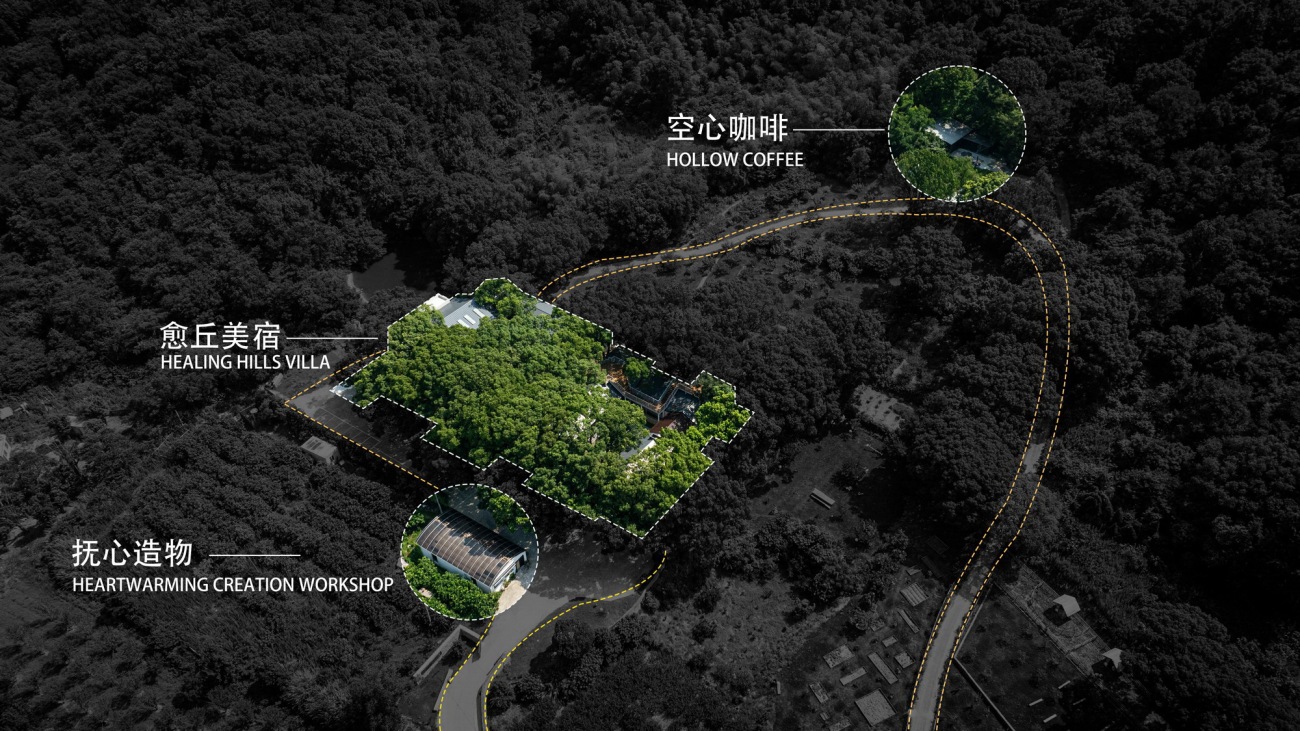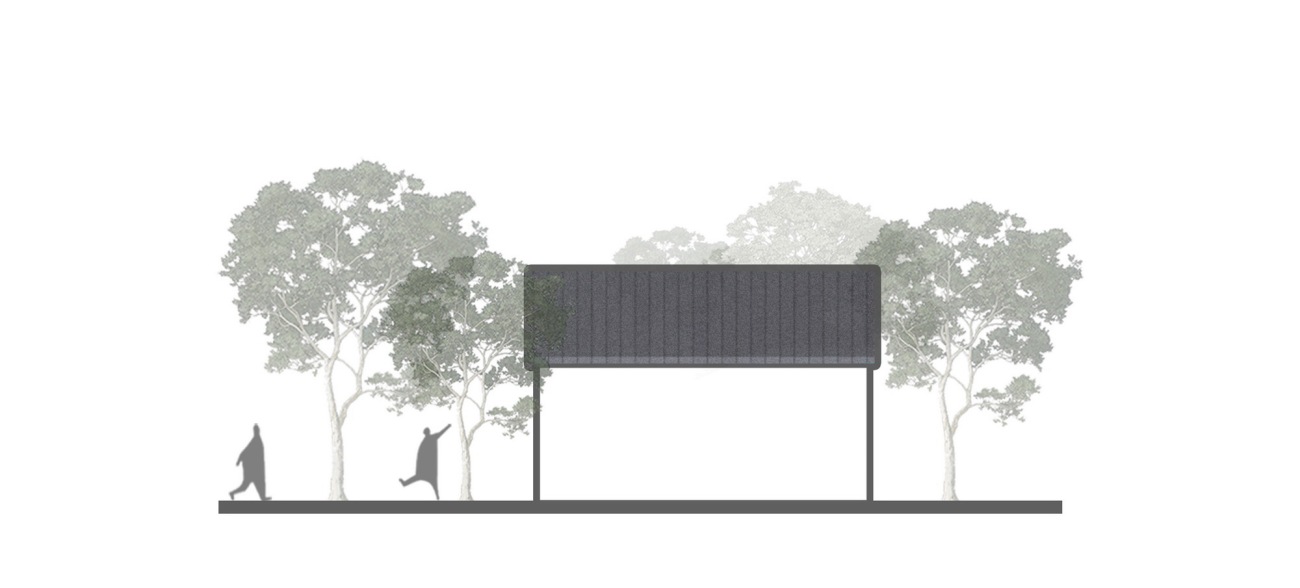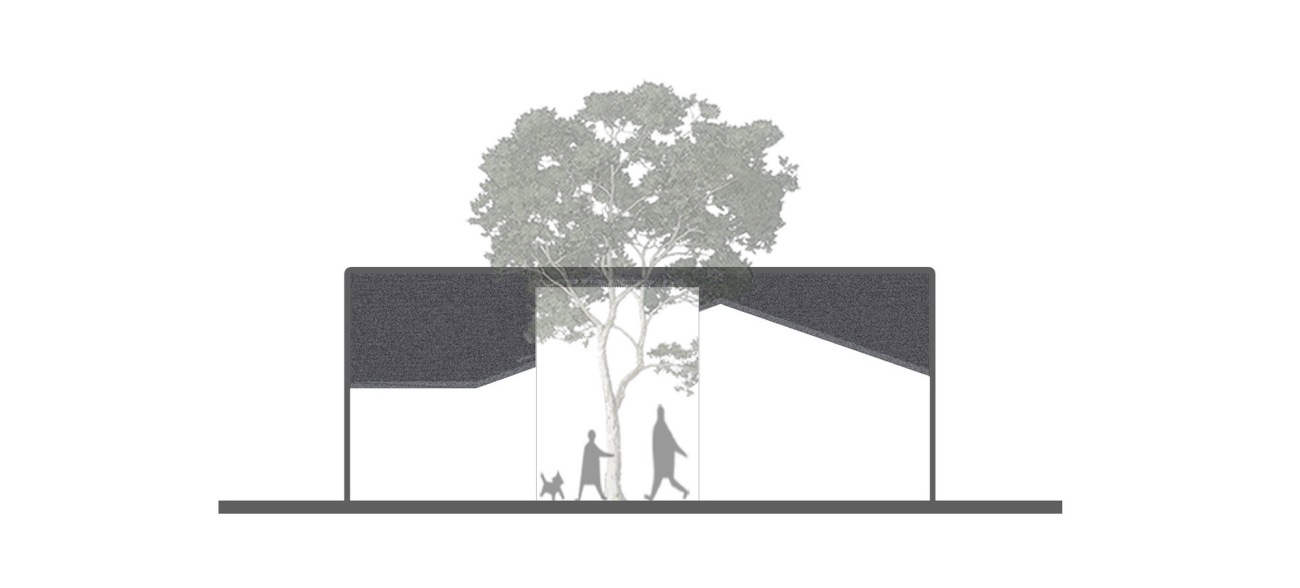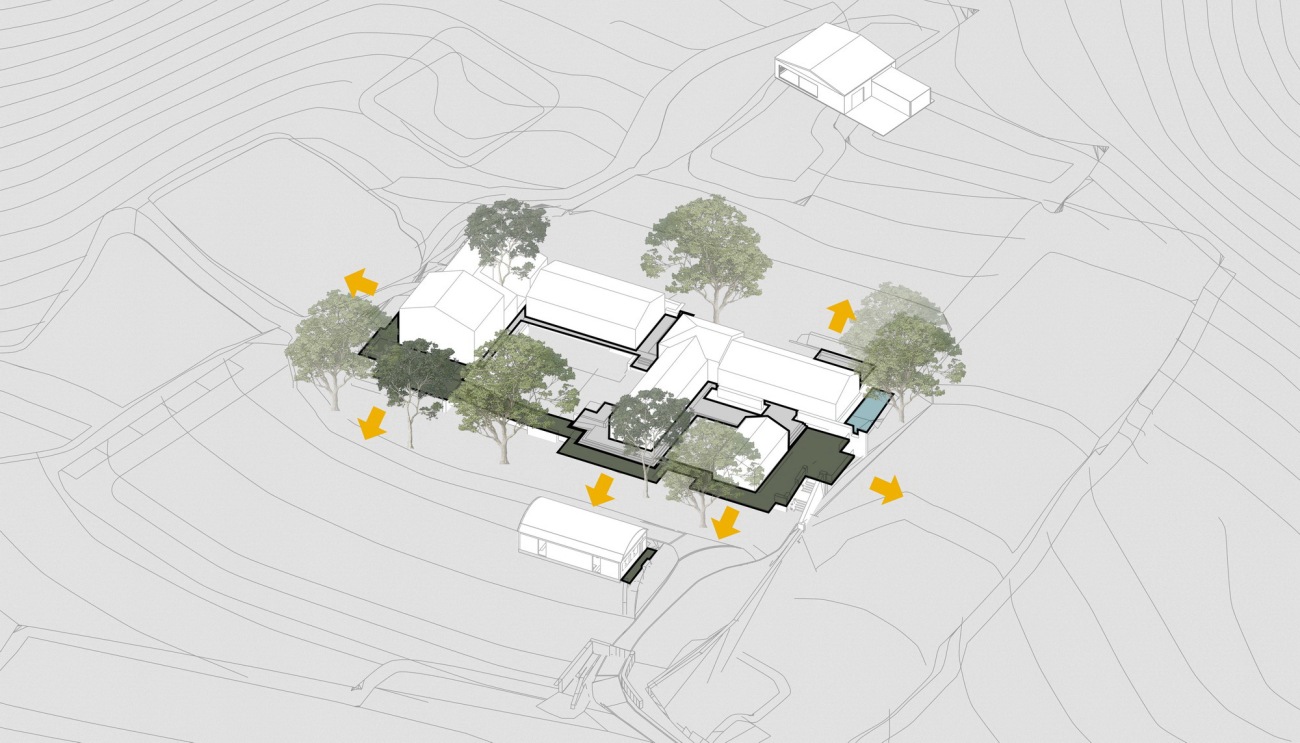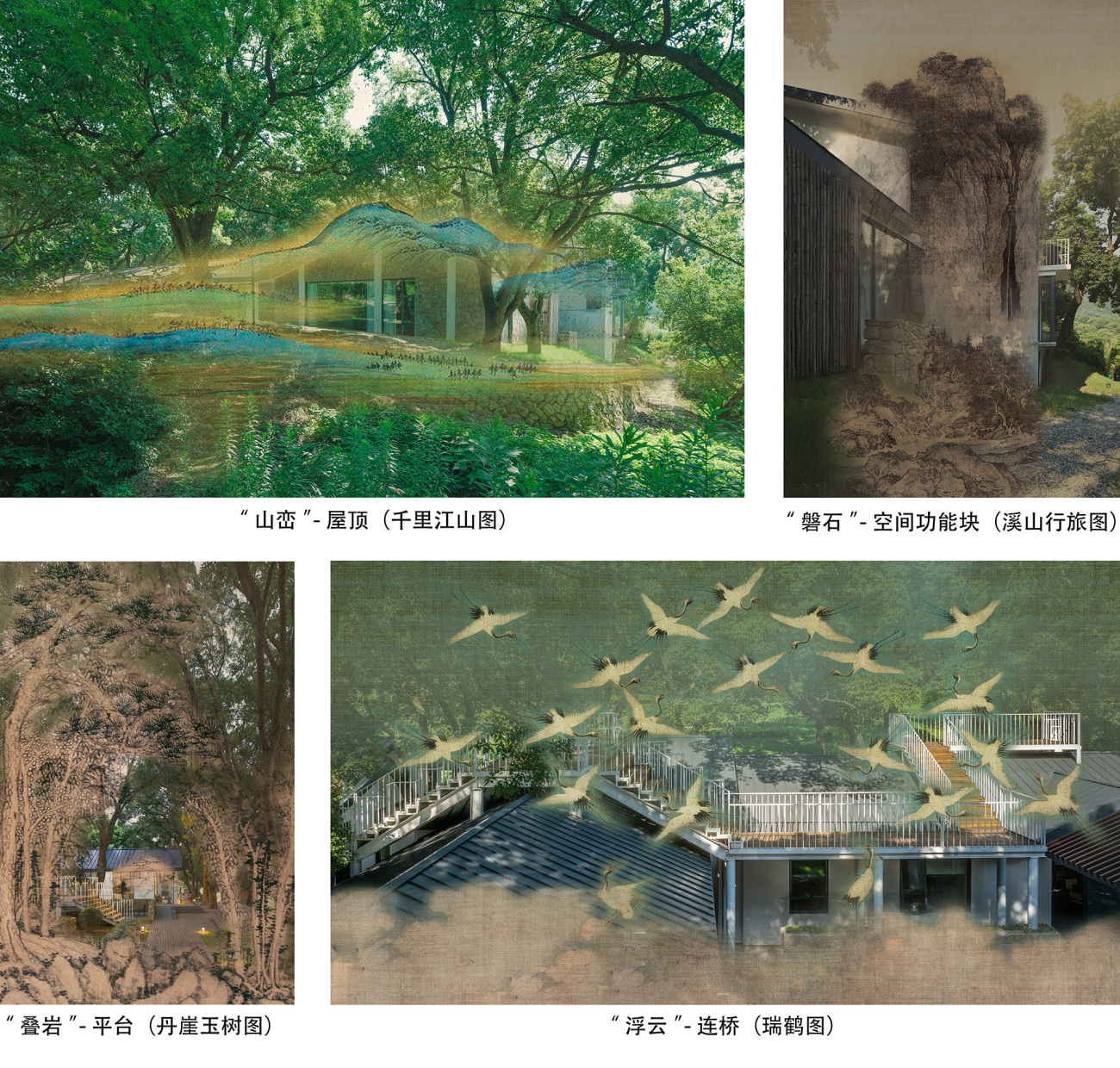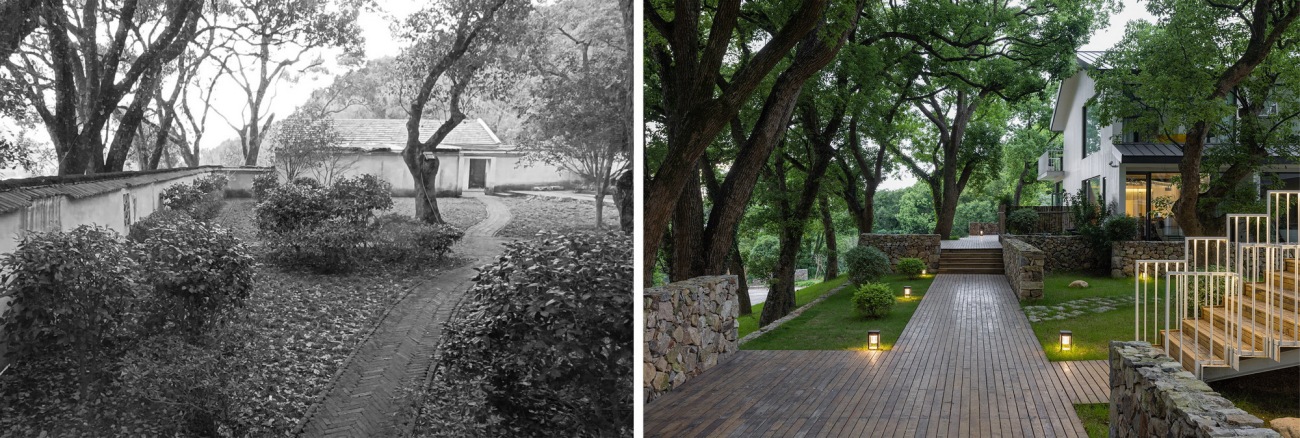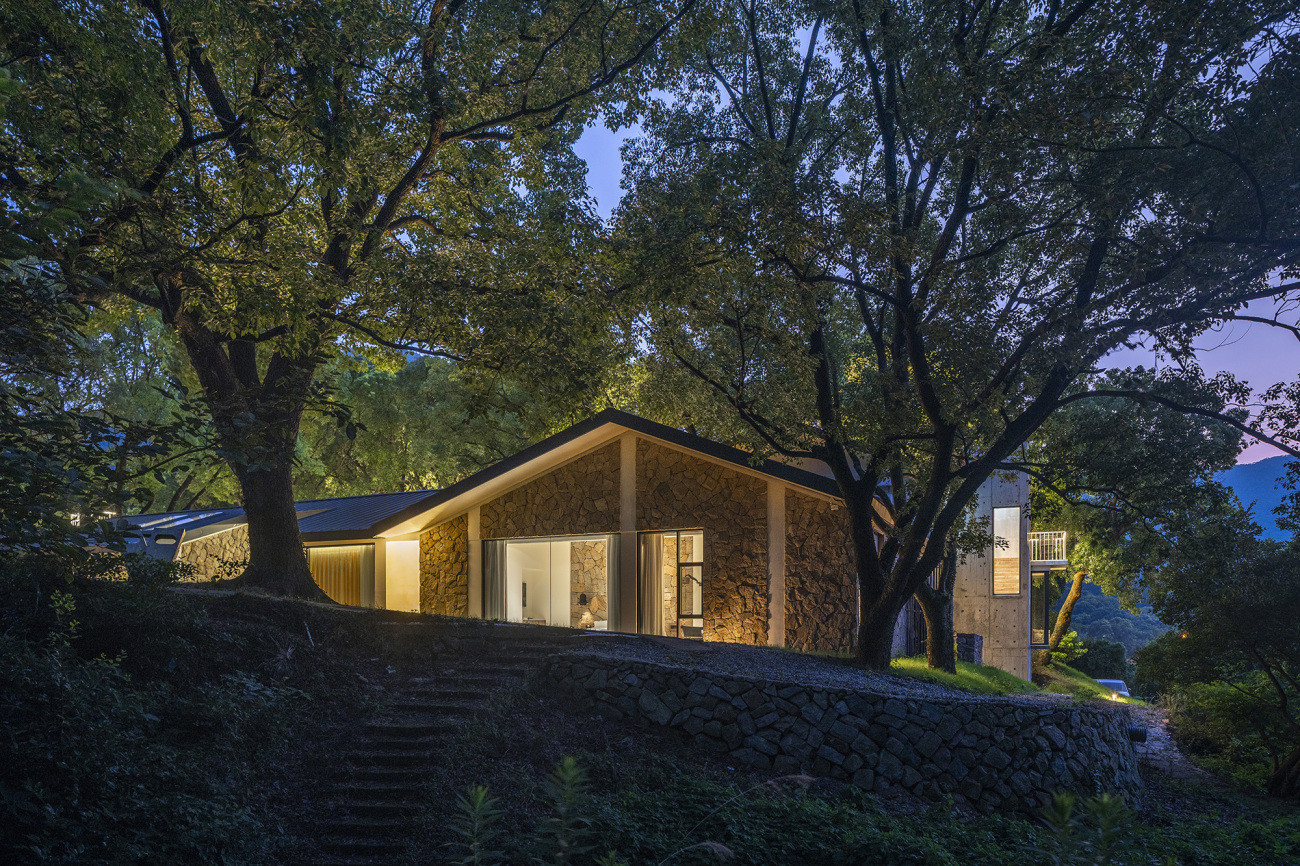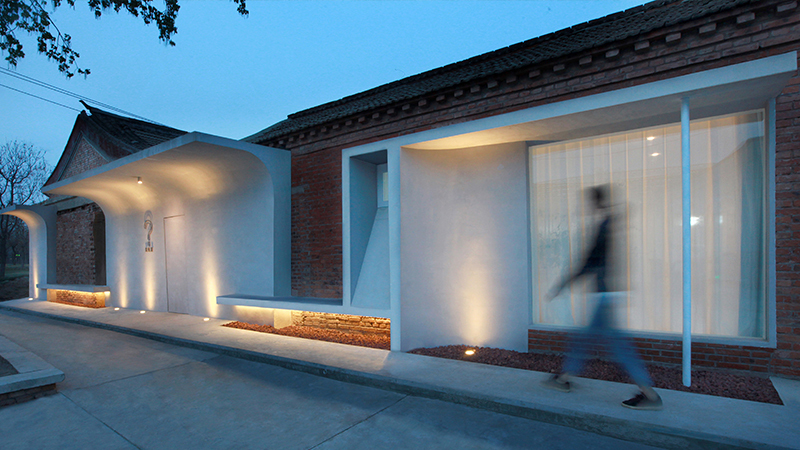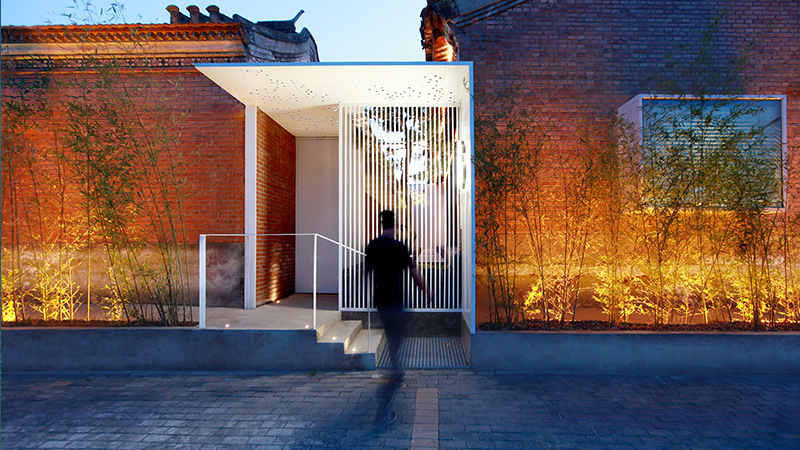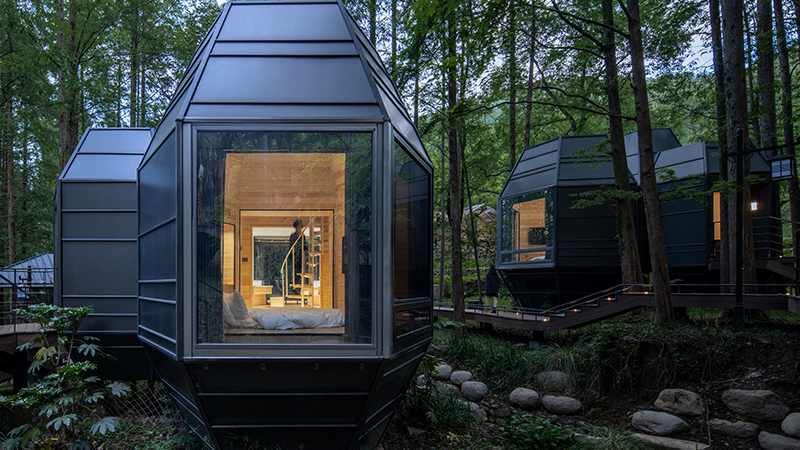“愈丘”原本是小山丘顶上一个荒废的院子,周围绿树环绕、盘根错节,让它如同置身于48棵老香樟树的庇护之下。
The Healing Hills Villa was originally a deserted courtyard atop a small hill, surrounded by lush green trees with twisting roots, making it feel as if it were protected by 48 old camphor trees.
▽鸟瞰定位图Bird's-eye view
改造对建筑空间的取舍,完全取决于“与树”的关系,即不强占,也不孤立。策略有三,首先,将散落的建筑群整合为三进院落,各院落间相对独立又紧密联系;其次,模糊建筑空间与自然环境的边界,树中有院,院中有树,让建筑向自然延伸,让自然向建筑渗透;最后,根据空间不同性质为其注入新的功能,在“人为”与“无为”之间架起感知的桥梁。
The transformation of the architectural space relies entirely on the relationship with the trees—neither encroaching upon them nor isolating them. There are three strategies. First, the scattered buildings were integrated into three courtyards, each relatively independent yet closely connected. Second, the boundaries between the built environment and the natural surroundings were blurred, allowing trees to coexist within the courtyards and the courtyards to extend into the trees, creating a seamless interaction between architecture and nature. Finally, new functions were infused based on the distinct characteristics of each space, creating a bridge of experience between the "artificial" and the "natural".
▽鸟瞰图Bird's-eye view
建筑与48颗老香樟树形成6种相互关系:
There are 6 relationships between architecture and 48 old camphor trees:
▽“环抱”,建筑藏匿树丛,融为一体;“Encircled”, the building is hidden in the trees, becoming one entity;
▽“围合”,建筑围绕大树,成为独院;“Encirclement”, the building surrounds the tree, becoming a separate courtyard;
▽“退让”,建筑避开大树长势复建,共同生长;“Retreat”, the building avoids the growth of the tree and is rebuilt to grow together;
▽“相望”,建筑面向大树打开,形成对景;“Gaze”, the building opens towards the tree, creating a panoramic view;
▽“夹嵌”,建筑之间既存大树,连接空间;“Impaction”, there was originally a big tree between the buildings, which was used to connect two spaces;
▽“映衬”,大树与矮墙互相遮挡,彼此衬托。“Contrast”, The trees and the low wall block each other and complement each other.
建筑取自自然、融于自然,设计将空间与中国传统画意中的自然形态相结合,提取“山峦”、“叠岩”、“浮云”与“磐石”4大要素,形成古典写意山水画的再转译。
Architecture draws from and merges with nature, with the design combining spatial elements with the natural forms found in traditional Chinese painting. It extracts 4 key elements — “Rolling Mountain”, “Stacked Platform”, “Floating Clouds” and “Towering Stones” — to create a reinterpretation of classical expressive landscape painting.
▽4大要素的提取Extraction of the 4 key elements
▽“山峦” —— 起伏的屋面“Rolling Mountain” — Undulating Roof
在原有建筑布局的基础上整合零散屋面,结合功能需要,梳理功能组团分区,最终形成“围绕”大树展开的三进院落形态。
Based on the original building layout, integrate the scattered roofs and, taking functional needs into account, delineate the functional zones, ultimately forming a three-courtyard layout that unfolds around the trees.
▽“叠岩” —— 延展的平台“Stacked Platform” — Expansive Platform
随着“愈丘”场地内地形的起伏,平台也高低层叠地“相望”于大树之间,成为空间的景观平台、活动场地,形成不同的空间体验。
With the undulating terrain of the Healing Hill Villa site, the platforms are stacked at varying heights, "gazing" at each other between the trees, creating a landscape space and activity area that offers diverse spatial experiences.
▽“浮云” —— 环绕的连桥“Floating Clouds” — Surrounding Bridge
连桥串联起三个院落空间,增加趣味动线,丰富游走体验,作为日常的风雨廊、立体景观通道以及亲子娱乐空间,满足多维功能需求。
The bridge connects the three courtyard spaces, enhancing the flow of movement and enriching the experience of wandering. Serving as a daily weather-protected walkway, a three-dimensional landscape passage, and a space for parent-child activities, it meets various functional needs.
▽“磐石”—— 置入的体块“Towering Stones” — Inserted Block
突出重要节点,并作为视觉高点和标识物,点缀其中。
Emphasize important nodes as visual focal points and landmarks, making them standout features within the space.
▽4大要素与实景结合的示意图Diagram of the four key elements combined with real scenes
在怡人的自然环境中,院落不仅是简单的围合场,更是精神的安身处;平台不仅是功能性的架构,更是情绪的释放地;连桥不仅是空间的纽带,更是文化和自然的交汇处。希望“重生”后的“愈丘”,能够唤醒心中沉睡的与生俱来的和自然的亲密性,借以自然的神力抚平焦躁不安的人心。
In the pleasant natural environment, the courtyard is not just a simple enclosed space but also a refuge for the spirit; the platform is not only a functional structure but also a place for emotional release; the bridge is not merely a connection between spaces but also an intersection of culture and nature. We hope that the "reborn" Healing Hill Villa can awaken the innate intimacy with nature that has lain dormant in our hearts, using nature's power to soothe restless souls.
顺地利之势,靠近主要道路的前院和中院,作为公共活动区; 临近水塘、场地平坦且环境静谧优美的后院,作为客房区;保留、改造原始建筑群中基础良好的部分,复建基础较差但具有一定存在价值的部分,再结合使用需求,进行局部拆除和新建。
Utilizing the topographical conditions, the Front Courtyard and the Middle Courtyard, located near the main road, will serve as public activity areas. The Back Courtyard, close to the pond and featuring a flat, tranquil environment, will be designated as the guest room area. We will retain and renovate the well-preserved sections of the original building, reconstruct areas with poor foundations but certain historical value, and carry out selective demolition and new construction based on functional needs.
入口处选用自然的毛石材料,使其与大树融为一景 ,降低围墙高度,将景色呼出,视线引入,向游客呈邀约之势。
Use natural stone to seamlessly blend the entrance with the trees, lowering the wall height to extend the scenery outward and draw the line of sight in, creating an inviting atmosphere for visitors.
▽入口改造前后对比Renovation comparison diagram
前院承担前台接待、早餐厅、休闲咖啡区等功能,可进行独立运营。利用矮石墙作为景观墙面,增加隐私性。
The Front Courtyard accommodates functions such as reception, a breakfast area, and a leisure coffee zone, allowing for independent operation. Use low stone walls as landscape features to enhance privacy.
▽前院入口平台改造前后对比图Renovation comparison diagram
由于早餐厅东侧树木倾斜,建筑拆除并退让复建,尊重其特殊性,并将大树独特造型引入室内。
Due to the leaning tree on the east side of the Breakfast Restaurant, the building was demolished and reconstructed to avoid it, respecting its uniqueness while incorporating the distinctive shape of the tree indoors
▽早餐厅东侧改造前后对比Renovation comparison diagram
▽早餐厅看向南侧农场Looking towards the southern farm from the Breakfast Restaurant
▽咖啡区Cafe
延长接待区建筑屋檐,连接原本独立的两个建筑体块,整合零散屋面,并串联前院和中院。
Extend the building eaves to connect the originally independent structures, integrating the scattered roofs and linking the Front Courtyard with the Middle Courtyard.
▽通道改造前后对比图(前院看向中院)Renovation comparison diagram
▽通道改造前后对比图(中院看向前院)Renovation comparison diagram
▽中院看向东侧连桥Looking towards the eastern Bridge from the Middle Courtyard
中院提供餐厅、厨房等配套服务。最大程度打开餐厅南北两侧的“景观面”,将中院和后院景观引入其中。
The Middle Courtyard features supporting services such as a restaurant and kitchen. Maximize the opening of the walls on the north and south sides of the Main Restaurant to minimize visual barriers, bringing the landscapes of the Middle Courtyard and the Back Courtyard into the space.
▽中院看向北侧餐厅Looking towards the northern Main Restaurant from the Middle Courtyard
▽餐厅串联中院和后院The Main Restaurant connects the Middle Courtyard and the Back Courtyard
后院主要满足客房及住店旅客日常活动的需要。拆除遮挡树木的高墙,平台围绕树木层叠延伸,将树景引入院内,将客人留置景中。
The Back Courtyard primarily caters to the daily activities of guests and visitors. By removing the tall walls that block the trees, the platform extends around the trees, bringing the tree scenery into the courtyard and immersing guests in the landscape.
▽后院改造前后对比图Renovation comparison diagram
▽后院看向南大床房Looking towards the South King-size Bed Room from the Back Courtyard
▽后院北侧建筑改造前后对比Renovation comparison diagram
▽后院看向东侧Looking towards the east side from the Back Courtyard
▽北侧建筑北立面North elevation of the northern building
▽北侧小路看向北侧建筑Looking towards the northern building from the north path
▽北侧看向北大床房Looking towards the North King-side Bed Room from the north side
▽东北侧山坡看向北大床房Looking towards the North King-side Bed Room from the northeast hillside
▽东侧山坡看向北侧、东侧客房Looking towards the northern and eastern rooms from the east hillside
8间布局不同的客房拥有各具特色的窗外景色,最大程度打开房间“景观面”,将“自然”引入室内;简化室内装饰,用“自然”装点室内。一幅画,一盏灯,一把座椅,在细节中点缀宁静闲适之美。暖色的毛石墙面为空间增添质感,使空间融于大自然,为其添上和谐一笔。
Eight uniquely laid-out rooms offer distinctive views, maximizing the openings on walls that reveal the landscape and bringing "nature" indoors. Interior decor is simplified, using "nature" to enhance the space. A painting, a lamp, and a chair subtly enhance the beauty of tranquility and relaxation. The warm stone walls add texture, blending the space with nature and fostering a harmonious coexistence.
▽南大床房South King-side Bed Room
▽南大床房看向后院Looking towards the Back Courtyard from the South King-side Bed Room
▽东大床房East King-side Bed Room
▽东大床房看向山坡Looking towards the hillside from the East King-side Bed Room
▽东套房卧室Bedroom of the East Suite
▽东套房客厅Living room of the East Suite
▽东套房客厅看向小院Looking towards the courtyard from the living room of the East Suite
▽东套房客厅西侧高窗一景The view from the high windows
▽北标间-2North Standard Room-2
▽北套房改造前后对比Renovation comparison diagram
▽从室内和后院看向保留的大树Looking towards the preserved trees from indoors and the Back Courtyard
▽树影婆娑Dappled sunlight through the trees
▽北大床房-1North King-side Bed Room
▽北套房-2卧室Bedroom of the North Suite-2
▽北套房-2客厅Living room of the North Suite-2
▽北套房-2看向后院Looking towards the Back Courtyard from the North Suite-2
▽北侧建筑楼梯间窗景View from the stairwell of the northern building
前院、中院和后院通过连桥串联,使三个院落在相对独立的基础上相互联系,连桥“穿梭”于建筑、大树之间,它不仅是架构在空间维度的“桥”,也是建构人与建筑、人与自然的“桥”。
The Bridge connects the Front, Middle, and Back Courtyard, linking the three spaces while maintaining their relative independence. The Bridge weaves through the buildings and trees, serving not only as connectors of space but also as “bridge” between people and architecture, as well as between people and nature.”
▽前院到中院连桥The Bridge of the Front Courtyard and the Middle Courtyard
▽后院连桥The Bridge of the Back Courtyard
▽连桥夜景Night view of the Bridge
在“愈丘”外围还有两处配套空间,作为民宿运营的功能辅助。
There are two auxiliary spaces around the Healing Hills Villa, serving as functional support for the operation of the guesthouse.
“抚心造物”工坊是“愈丘”西侧废旧仓库改造而来,利用其良好的顶部采光优势改造为手作工坊,室内避免过繁装饰以尽量留存建筑原始“气息”。
The Heartwarming Creation Workshop is transformed from an old warehouse on the west side of the Healing Hills Villa, taking advantage of the excellent natural light from the ceiling. The interior avoids excessive decoration to preserve the original "essence" of the building as much as possible.
▽“抚心造物”改造前后对比Renovation comparison diagram
▽“抚心造物”入口外立面Entrance of the Heartwarming Creation Workshop
▽“抚心造物”轴测图Spatial axonometric
“空心咖啡”位于“愈丘”的东侧,四面环竹、幽静怡人,最大程度打开“景观面”,让空间向自然“敞开”,让人们向本真“袒露”。
The Hollow Coffee is located on the east side of the Healing Hills Villa surrounded by bamboo and offering a tranquil atmosphere. It maximizes the opening of walls that obstruct the view, allowing the space to open up to nature and invite people to reveal their true selves.
▽“空心咖啡”鸟瞰图Bird's-eye view of the Hollow Coffee
▽咖啡区入口Entrance of the Hollow Coffee
▽咖啡区西侧窗景View from the west side of the Hollow Coffee
▽咖啡区北侧窗景View from the north side of the Hollow Coffee
▽“空心咖啡”轴测图Spatial axonometric
▽总平面图Site plan
▽平面布置图Floor plan
▽南北剖面图North-South section
▽前院东西剖面图East-West section of the Front Courtyard
▽后院东西剖面East-West section of the Back Courtyard
项目名称(中文):抚心集·愈丘Villa山野美宿
项目名称(英文):Healing Hills Villa
项目地址:浙江省舟山市普陀区展茅街道
设计单位:介隐建筑事务所
主持建筑师:沈圣喆
设计团队:孟雪源、关静茹、肖惠敏、姚燕、肖鹏
技术顾问:金楠
结构专业:苏志杰
设备专业:刘珊珊
照明设计:董天华
项目摄影:介隐建筑、金伟琦、胡颖
公司官网:www.zen-in.cn
更新日期:2024-10-17 14:57:18
非常感谢 介隐建筑事务所 带来的精彩项目, 查阅更多Appreciations towards Jie Yin Architects for sharing wonderful work on hhlloo. Click to see more works!
